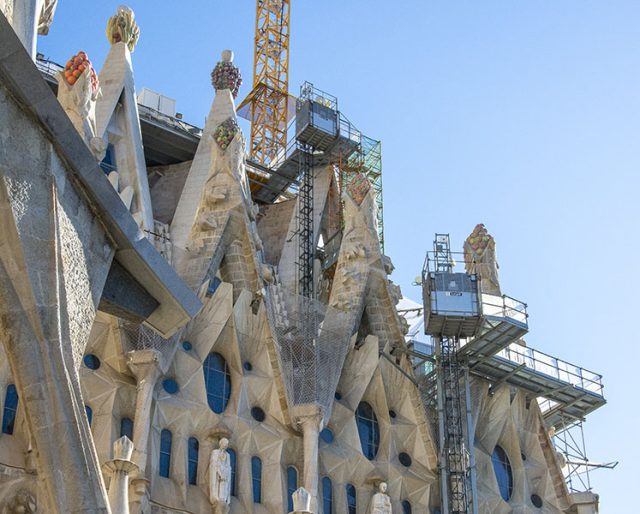
Surely you have heard of one of the most famous temples in the world: La Sagrada Familia. In fact, it is arguably one of Barcelona’s most iconic landmarks.
This majestic architectural masterpiece is visited by millions of people throughout the year due to its unique design and impressive size. It is also the subject of study by many future architects from all over the world, who travel to the city to see this marvel with their own eyes and learn about it, while taking a Spanish class Barcelona simultaneously.
However, one of the most enigmatic details of this work is that it has been unfinished for at least 140 years. Yes! 140 years ago, its construction began and still needs to be finished.
Unfortunately, the mastermind behind this creation, Antoni Gaudí (a famous Catalan architect), died in 1926 and could not finish his work because it was a highly ambitious project. He only managed to see the completion of one bell tower before he died. What happened?
Tourists from all over the world travel to the Catalan community to experience the entrance to the highest and most original temple in the world. It is true that there is a lot to see and do in Barcelona, besides the fact that it is one of the most chosen cities to take a Spanish course, but La Sagrada Familia is still one of the main tourist attractions of the city.
Let’s see the story behind this imposing architectural project.
The beginning
The original project for the construction of the Sagrada Familia began in 1882 by the architect Francisco de Paula del Villar. However, he was dismissed for failing to reach an agreement regarding the cost of materials. Despite this dismissal, construction began on March 19 of that same year.
The following year, in 1883, Antoni Gaudí took over the project, which was when the magic happened. Del Villar’s original design was different from what Gaudí later proposed. It was a much more conservative project in the classical style.
In any case, it was not until 1914 that Gaudí could devote himself exclusively to the construction of La Sagrada Familia, and he did so until his death.
During this period, he was able to see the bell tower of San Bernabé, located on the Nativity facade, completely finished. However, that was the only thing he got to experience, as it happened in 1925, just a year before his death.
Knowing that he would not be able to see his work finished, he left all the necessary instructions and plans for the construction to continue even after his death. Thus, the direction of the project was assumed by his disciple Sugranyes in 1926.
Since then, there have been several architects who have taken charge of the work. Domènec Sugranyes was followed by Frencesc de Paula Quintana (1939). When Quintana died in 1966, Lluís Bonet i Garí and Isidre Puig i Boada followed; then, the direction passed into the hands of Francesc Cardoneri i Blanch in 1983. Then followed Jordi Bonet i Armengol in 1985, and finally, in 2012, the architect Jordi Faulí took over, who continues to direct the project to this day and hopes to finish the work by 2026, the 100th anniversary of Gaudí’s death.
Why is the work still unfinished after so much time?
After 140 years, it cannot be said that La Sagrada Familia was not finished for a single reason, but rather that several factors caused the work to take so long.
However, one factor greatly hindered the temple’s construction, which was one of the most influential aspects of this time. We are referring to the Spanish Civil War, which lasted from 1936 to 1939.
During that time, acts of vandalism occurred in which plaster models, plans, and other documents, such as photographs, of the Sagrada Familia project left by Gaudí were burned. This slowed down the work process, which was resumed only in 1939 through the material saved from the architect’s workshop.
It is also necessary to mention that in 2020, the work had to stop for several months due to the world’s situation because of covid-19.
In addition to all this, the pace of construction was never constant throughout history as it has always depended on the contributions of the people. In the beginning, the work was financed through the contributions of the faithful and donations. Nowadays, it is funded by the money collected from tourists’ entrance fees.
Gaudí always knew that the construction would take a long time due to the immense dimensions of the project, so he understood that it would be a work carried out by different generations. Gaudí expressed that the temple’s owner (God) was in no hurry.

What has been built so far?
Gaudí’s project consists of 5 naves, an outer ambulatory in the form of an abbey, an apse, 3 facades, and 18 towers, and every corner overflows with symbolism. Gaudí wanted the temple to be seen with perspective from all sides.
In 1885 the chapel of San José was inaugurated, where the first masses could be celebrated. In 1891, the Nativity facade began, and the bell tower of San Bernabé was the only part that Gaudí could see finished before his death.
It seems that this year two towers of the evangelists (there are four in total) will be finished; they are the tower of St. Luke and St. Mark, which will be crowned with their respective symbols: the ox and the lion.
The intention is that the other two towers, those of St. Matthew and St. John, will be finished next year, which would mean that by 2023 the four towers would be completed, which will be the third tallest in the temple, after the tower of the Virgin Mary and the building of Jesus.
The towers of the evangelists will measure 135 meters. In comparison, that of the Virgin Mary (which is already finished and was crowned with an imposing star illuminated at night) measures 138 meters. Finally, the tower of Jesus will have a height of 171 meters since Gaudí intended to build a very tall temple in order to connect heaven with earth; however, he did not want it to be higher than Mount Montjuic.
Today the Jesus Tower is 126 meters high and has 8 floors of the 12 that will be built. The architect Faulí hopes to be able to finish the construction by 2026, when the centenary of Gaudí’s death is celebrated, although everything depends on the income from the entrance fees to the temple. All indications are that if visitors continue to arrive as they have been so far.





